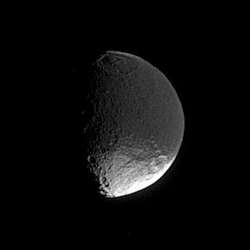
Saturn’s moon Iapetus. Image credit: NASA/JPL/SSI. Click to enlarge
This Cassini image shows the darker side of Saturn’s moon Iapetus. Scientists aren’t sure why, but Iapetus’ leading hemisphere is much darker than its trailing hemisphere. At the top of the image, it’s possible to see a large impact basin 400 km (250 miles) wide. Cassini took this photograph on April 4, 2006, at a distance of approximately 1.4 million kilometers (900,000 miles) from Iapetus.
A distant glimpse of Iapetus reveals details within the dark terrain of Cassini Regio, including an impact basin at top that is roughly 400 kilometers (250 miles) wide.
Researchers remain unsure about the mechanism that has darkened the leading hemisphere.
This view looks toward the southern hemisphere on the leading side of Iapetus (1,468 kilometers, or 912 miles across). North is up.
The image was taken in visible light with the Cassini spacecraft narrow-angle camera on April 4, 2006, at a distance of approximately 1.4 million kilometers (900,000 miles) from Iapetus. The image scale is 9 kilometers (6 miles) per pixel.
The Cassini-Huygens mission is a cooperative project of NASA, the European Space Agency and the Italian Space Agency. The Jet Propulsion Laboratory, a division of the California Institute of Technology in Pasadena, manages the mission for NASA’s Science Mission Directorate, Washington, D.C. The Cassini orbiter and its two onboard cameras were designed, developed and assembled at JPL. The imaging operations center is based at the Space Science Institute in Boulder, Colo.
For more information about the Cassini-Huygens mission visit http://saturn.jpl.nasa.gov . The Cassini imaging team homepage is at http://ciclops.org .
Original Source: NASA/JPL/SSI News Release
